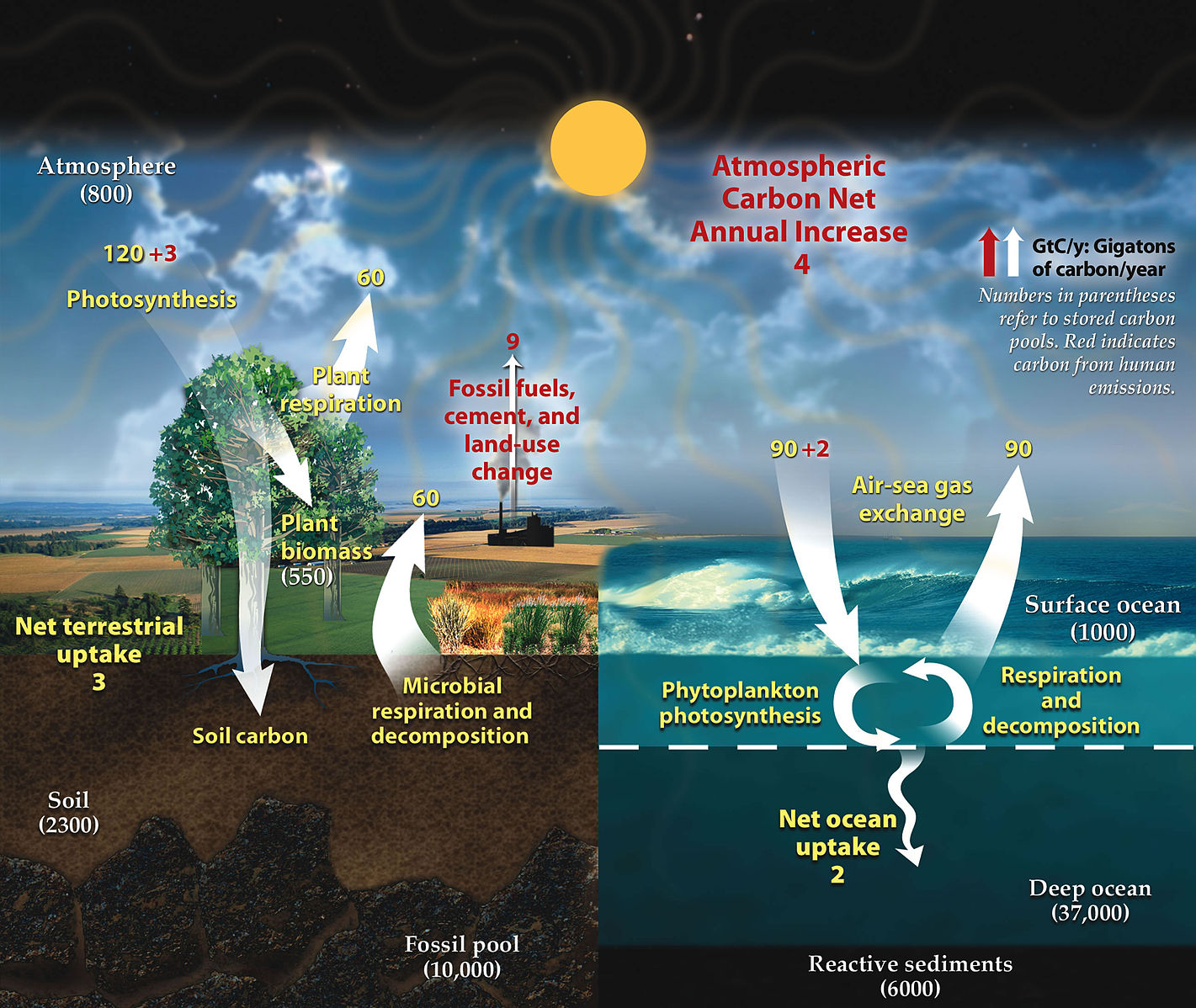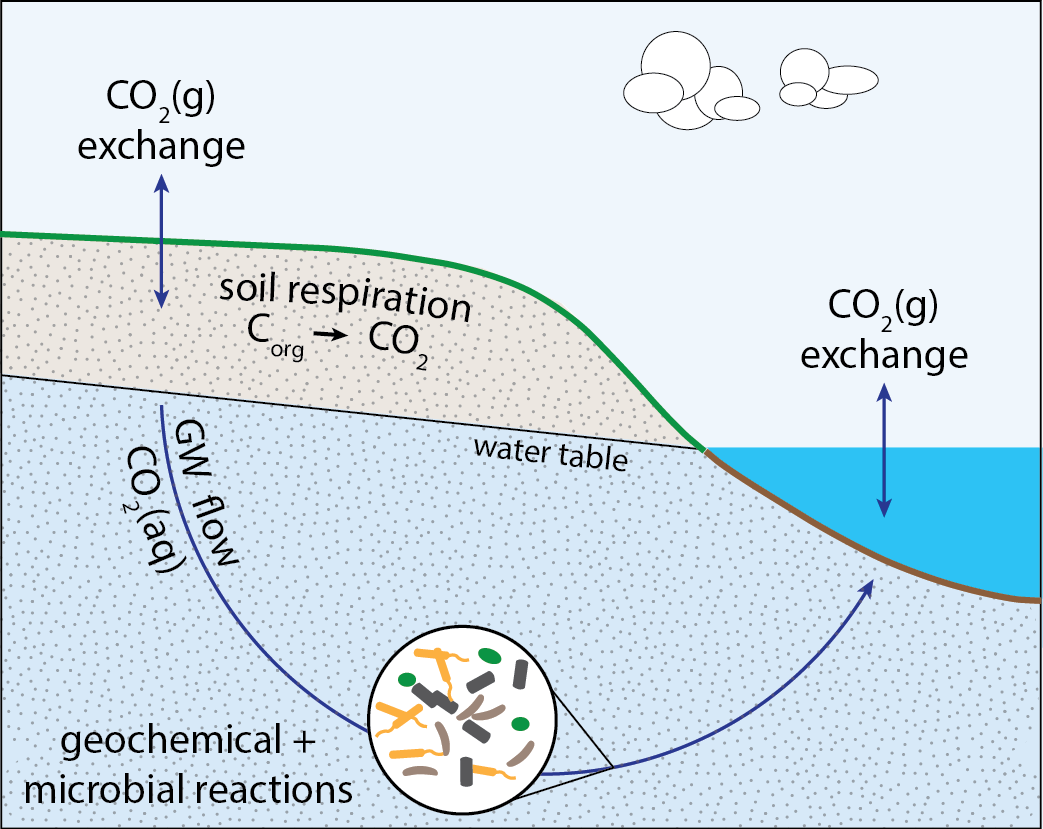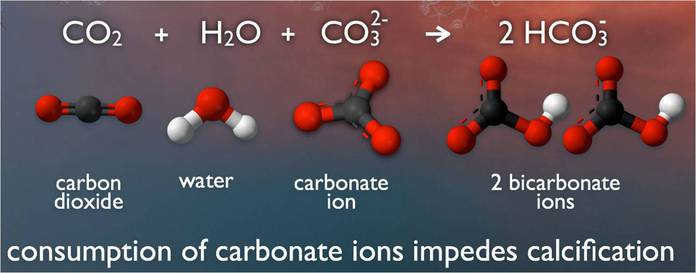The carbon cycle is integral to life on Earth, governing the circulation of carbon among the atmosphere, living organisms, oceans, and soil. This process is pivotal for climate regulation and the support of life.
Stages of the Carbon Cycle
1. Carbon Dioxide in the Atmosphere
Carbon is primarily present in the Earth's atmosphere as carbon dioxide (CO2). This greenhouse gas is essential for life but can also contribute to climate change when present in excessive amounts.
Photosynthesis: Plants, algae, and cyanobacteria absorb atmospheric CO2 and sunlight to produce glucose and oxygen. This biochemical process is the cornerstone of life on Earth, as it generates organic compounds and oxygen necessary for most organisms.

This diagram summarises exchanges of carbon among the atmosphere, land plants and soils, oceans, and long-term geological stores, with arrows indicating major fluxes and boxes indicating reservoirs. It also depicts human influences such as fossil-fuel combustion and land-use change. The figure includes flux values that go beyond the syllabus; these add context on the scale of transfers. Source.
2. Carbon Sequestration in Plants
Plants are pivotal in the carbon cycle, acting as carbon sinks that absorb and store CO2 from the atmosphere.
Biomass Accumulation: As plants grow, they store carbon in their tissues, contributing to the formation of biomass. This process is a natural method of carbon sequestration, reducing the amount of CO2 in the atmosphere.
Decomposition: When plants die, their stored carbon is either released back into the atmosphere or transferred into the soil. Decomposers like bacteria and fungi break down the dead organic material, a process that releases CO2.
3. Carbon in the Oceans
Oceans are significant carbon reservoirs, absorbing a large portion of the CO2 released into the atmosphere.
Gas Exchange: CO2 is exchanged between the atmosphere and ocean surfaces. This process is influenced by temperature, salinity, and other factors.
Carbonate Formation: Marine organisms like corals and molluscs use dissolved CO2 to form calcium carbonate structures. When these organisms die, their shells and skeletons sink to the ocean floor, leading to the formation of sedimentary rocks and storing carbon for millions of years. This process is closely linked with the broader effects of ocean acidification.
4. Carbon in the Soil
Soil is another crucial component of the carbon cycle, storing carbon in the form of decomposed organic matter.
Humus Formation: Decomposed plant and animal material forms humus, a rich, organic material that stores carbon in the soil.
Soil Respiration: Microorganisms in the soil decompose organic matter, releasing CO2 back into the atmosphere. This process is a significant source of atmospheric CO2.

This schematic shows potential fates of CO₂ produced during soil respiration: diffusion to the atmosphere or transport in groundwater to adjacent surface waters, where it can outgas. It reinforces the role of soils as a CO₂ source while linking terrestrial and aquatic systems. Source.
5. Fossil Fuels and Sedimentary Rocks
The transformation of organic material into fossil fuels and sedimentary rocks over millions of years has resulted in the storage of vast amounts of carbon underground.
Fossilisation: Organic material is converted into coal, oil, and natural gas through heat and pressure over geological timescales.
Carbonate Rock Formation: The accumulation of calcium carbonate forms rocks like limestone, which store carbon over extended periods.
Human Impact on the Carbon Cycle
Increased Carbon Emissions
The advent of industrialisation has led to a significant increase in carbon emissions, primarily due to the burning of fossil fuels and deforestation.
Fossil Fuel Combustion: The extraction and burning of coal, oil, and natural gas for energy have released large amounts of CO2, previously stored underground, into the atmosphere.
Deforestation: The large-scale removal of forests for agriculture, urban development, and other purposes has reduced the Earth’s capacity to absorb and store CO2. Explore more on the impacts of deforestation.
Climate Change
The increase in CO2 and other greenhouse gases in the atmosphere has led to global warming and climate change, impacting ecosystems and human societies worldwide.
Temperature Rise: The enhanced greenhouse effect traps more heat in the Earth’s atmosphere, leading to a rise in global temperatures. This warming affects weather patterns, sea levels, and ecosystems. Further details on climate change can be found here.
Ocean Acidification: Increased CO2 levels lead to higher ocean acidity, affecting marine biodiversity, coral reefs, and the overall health of oceans.

This molecular diagram illustrates the overall seawater reaction: CO₂ + H₂O + CO₃²⁻ → 2 HCO₃⁻, which lowers carbonate-ion availability and impedes calcification in corals and shell-forming organisms. It directly links rising atmospheric CO₂ to reduced aragonite saturation. Source.
Mitigation Strategies
Efforts to mitigate the impact of increased CO2 levels focus on reducing emissions and enhancing natural carbon sinks.
Renewable Energy: Transitioning to renewable energy sources like wind, solar, and hydroelectric power is pivotal to reducing CO2 emissions from fossil fuel combustion.
Afforestation and Reforestation: Planting trees and restoring forests can increase carbon sequestration, restore ecosystems, and combat climate change.
Carbon Capture and Storage: Technologies that capture and store CO2 emissions from power plants and industrial sources can reduce the amount of CO2 released into the atmosphere. Read about carbon capture and storage techniques.
Policy and Regulation
Implementing policies and regulations is crucial to mitigating the human impact on the carbon cycle.
Carbon Pricing: Mechanisms like carbon taxes or cap-and-trade systems can incentivise the reduction of greenhouse gas emissions.
International Agreements: Global initiatives like the Paris Agreement aim to unite countries in the effort to limit global temperature rise and promote sustainable practices.
Adaptation and Resilience
Building resilience and adapting to the changes induced by the altered carbon cycle is essential to mitigate the impacts of climate change.
Ecosystem Restoration: Efforts to restore and protect ecosystems can enhance their natural capacity to absorb CO2 and support biodiversity.
Infrastructure Improvement: Enhancing infrastructure to withstand extreme weather events and changing environmental conditions is crucial for adapting to climate change.
Understanding the intricate dynamics of the carbon cycle and the significant human impact is essential for developing strategies to restore its balance. By adopting sustainable practices, reducing emissions, and enhancing natural carbon sinks, the equilibrium of the carbon cycle can be restored, mitigating the adverse effects of climate change. Additional information on the interconnected nitrogen cycle is also crucial.
FAQ
The carbon cycle directly influences the Earth's climate by regulating the amount of CO2, a key greenhouse gas, in the atmosphere. CO2 contributes to the greenhouse effect, where gases trap heat in the Earth's atmosphere, leading to a rise in global temperatures. The natural carbon cycle ensures a balance, with processes like photosynthesis and ocean absorption removing CO2 from the atmosphere. However, human activities have disrupted this balance, leading to increased atmospheric CO2 and an enhanced greenhouse effect, resulting in global warming and climate change, with impacts on weather patterns, sea levels, and ecosystems.
Animals contribute to the carbon cycle primarily through respiration and waste production. They inhale oxygen and exhale CO2, releasing carbon into the atmosphere. The decomposition of animal waste and dead organisms also releases CO2. Changes in animal populations can impact this cycle. For example, a decline in herbivore populations can lead to increased plant biomass and potentially more carbon sequestration. Conversely, an increase in herbivores might lead to reduced plant biomass and less carbon storage. Thus, fluctuations in animal populations can influence the amount of atmospheric CO2 and, subsequently, climate change.
Technological innovations play a crucial role in mitigating the impacts of increased CO2. Carbon capture and storage (CCS) technologies trap CO2 emissions produced from the use of fossil fuels in power generation and industrial processes, preventing CO2 from entering the atmosphere. Bioenergy with carbon capture and storage (BECCS) goes a step further, combining biomass energy generation with CCS, effectively removing CO2 from the atmosphere. Additionally, advancements in renewable energy technologies, such as solar, wind, and hydroelectric power, are reducing our reliance on fossil fuels, decreasing CO2 emissions and mitigating their impacts on the carbon cycle.
The carbon cycle is intricately linked with other biogeochemical cycles, including the water, nitrogen, and phosphorus cycles. For instance, the process of photosynthesis, pivotal in the carbon cycle, requires water. Additionally, the decomposition of organic matter releases not only carbon but also nutrients like nitrogen and phosphorus back into the soil. Forest fires, fueled by organic carbon, release nitrogen and other nutrients into the atmosphere. In aquatic ecosystems, the cycles are interconnected; for example, carbon compounds can bind with nutrients, affecting their availability to aquatic life. These interactions underscore the complexity and interdependence of Earth's biogeochemical cycles.
The increased concentration of atmospheric CO2 leads to a higher absorption of the gas by oceans, causing ocean acidification. As CO2 dissolves in seawater, it forms carbonic acid, which dissociates to release hydrogen ions, lowering the ocean's pH. This acidification affects marine life, particularly calcifying organisms like corals, molluscs, and certain types of plankton. The increased acidity interferes with the ability of these organisms to build and maintain calcium carbonate skeletons and shells. Consequently, this can lead to weaker structures, reduced growth rates, and, in the case of corals, bleaching and decreased biodiversity within reef ecosystems.
Practice Questions
Human activities, especially fossil fuel combustion and deforestation, have significantly disrupted the carbon cycle. The burning of coal, oil, and natural gas releases an immense amount of CO2, previously sequestered underground, into the atmosphere. This increase in greenhouse gases exacerbates the greenhouse effect, leading to global warming. Deforestation exacerbates the issue; by clearing forests, the Earth's capacity to absorb and store CO2 is diminished. Trees and plants act as carbon sinks, and their removal accelerates the increase in atmospheric CO2, contributing to climate change and its associated impacts on ecosystems and weather patterns.
Oceans and soil are integral components of the natural carbon cycle, acting as significant carbon sinks that mitigate the effects of increased atmospheric CO2. Oceans absorb a large portion of CO2 from the atmosphere through gas exchange, and marine organisms utilise CO2 to form calcium carbonate structures, sequestering carbon in the ocean floor. Soil, rich in organic matter, stores carbon through the decomposition of dead plants and animals. Microorganisms in the soil break down this organic material, converting it into humus and storing carbon. Both oceans and soil play pivotal roles in regulating atmospheric CO2 levels, thus mitigating climate change.

